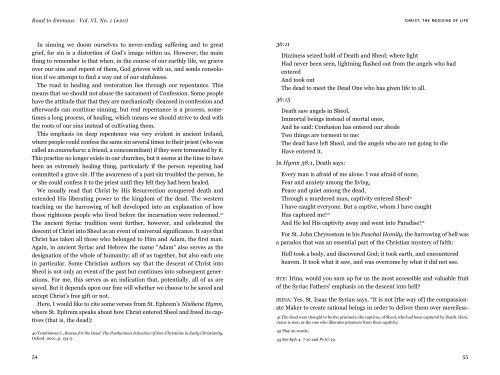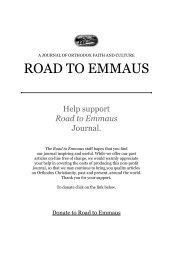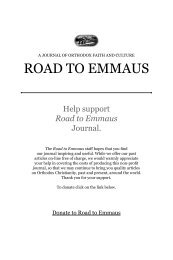RTE No 20 Interior - Road to Emmaus Journal
RTE No 20 Interior - Road to Emmaus Journal
RTE No 20 Interior - Road to Emmaus Journal
You also want an ePaper? Increase the reach of your titles
YUMPU automatically turns print PDFs into web optimized ePapers that Google loves.
<strong>Road</strong> <strong>to</strong> <strong>Emmaus</strong> Vol. VI, <strong>No</strong>. 1 (#<strong>20</strong>)CHRIST, THE MEDICINE OF LIFEIn sinning we doom ourselves <strong>to</strong> never-ending suffering and <strong>to</strong> greatgrief, for sin is a dis<strong>to</strong>rtion of God’s image within us. However, the mainthing <strong>to</strong> remember is that when, in the course of our earthly life, we grieveover our sins and repent of them, God grieves with us, and sends consolationif we attempt <strong>to</strong> find a way out of our sinfulness.The road <strong>to</strong> healing and res<strong>to</strong>ration lies through our repentance. Thismeans that we should not abuse the sacrament of Confession. Some peoplehave the attitude that that they are mechanically cleansed in confession andafterwards can continue sinning, but real repentance is a process, sometimesa long process, of healing, which means we should strive <strong>to</strong> deal withthe roots of our sins instead of cultivating them.This emphasis on deep repentence was very evident in ancient Ireland,where people could confess the same sin several times <strong>to</strong> their priest (who wascalled an anamchara: a friend, a concommitant) if they were <strong>to</strong>rmented by it.This practice no longer exists in our churches, but it seems at the time <strong>to</strong> havebeen an extremely healing thing, particularly if the person repenting hadcommitted a grave sin. If the awareness of a past sin troubled the person, heor she could confess it <strong>to</strong> the priest until they felt they had been healed.We usually read that Christ by His Resurrection conquered death andextended His liberating power <strong>to</strong> the kingdom of the dead. The westernteaching on the harrowing of hell developed in<strong>to</strong> an explanation of howthose righteous people who lived before the incarnation were redeemed. 40The ancient Syriac tradition went further, however, and celebrated thedescent of Christ in<strong>to</strong> Sheol as an event of universal significance. It says thatChrist has taken all those who belonged <strong>to</strong> Him and Adam, the first man.Again, in ancient Syriac and Hebrew the name “Adam” also serves as thedesignation of the whole of humanity; all of us <strong>to</strong>gether, but also each onein particular. Some Christian authors say that the descent of Christ in<strong>to</strong>Sheol is not only an event of the past but continues in<strong>to</strong> subsequent generations.For me, this serves as an indication that, potentially, all of us aresaved. But it depends upon our free will whether we choose <strong>to</strong> be saved andaccept Christ’s free gift or not.Here, I would like <strong>to</strong> cite some verses from St. Ephrem’s Nisibene Hymn,where St. Ephrem speaks about how Christ entered Sheol and freed its captives(that is, the dead):40 Trumbower J., Rescue for the Dead. The Posthumous Salvation of <strong>No</strong>n-Christians in Early Christianity,Oxford: <strong>20</strong>01, p. 154-5.36:11Dizziness seized hold of Death and Sheol; where lightHad never been seen, lightning flashed out from the angels who hadenteredAnd <strong>to</strong>ok outThe dead <strong>to</strong> meet the Dead One who has given life <strong>to</strong> all.36:15Death saw angels in Sheol,Immortal beings instead of mortal ones,And he said: Confusion has entered our abodeTwo things are <strong>to</strong>rment <strong>to</strong> me:The dead have left Sheol, and the angels who are not going <strong>to</strong> dieHave entered it.In Hymn 38:1, Death says:Every man is afraid of me alone. I was afraid of none,Fear and anxiety among the living,Peace and quiet among the dead,Through a murdered man, captivity entered Sheol 41I have caught everyone. But a captive, whom I have caughtHas captured me! 42And He led His captivity away and went in<strong>to</strong> Paradise! 43For St. John Chrysos<strong>to</strong>m in his Paschal Homily, the harrowing of hell wasa paradox that was an essential part of the Christian mystery of faith:Hell <strong>to</strong>ok a body, and discovered God; it <strong>to</strong>ok earth, and encounteredheaven. It <strong>to</strong>ok what it saw, and was overcome by what it did not see.<strong>RTE</strong>: Irina, would you sum up for us the most accessible and valuable frui<strong>to</strong>f the Syriac Fathers’ emphasis on the descent in<strong>to</strong> hell?IRINA: Yes. St. Isaac the Syrian says, “It is not [the way of] the compassionateMaker <strong>to</strong> create rational beings in order <strong>to</strong> deliver them over merciless-41 The dead were thought <strong>to</strong> be the prisoners, the captives, of Sheol, who had been captured by Death. Here,Jesus is seen as the one who liberates prisoners from their captivity.42 Play on words.43 See Eph 4: 7-10 and Ps 67:19.5455










